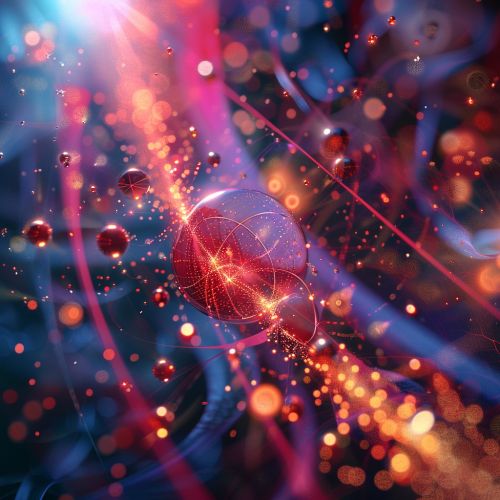Quantum Boltzmann equation
Quantum Boltzmann Equation
The Quantum Boltzmann equation is a fundamental equation in the field of statistical mechanics and quantum mechanics. It extends the classical Boltzmann equation to quantum systems, providing a framework to describe the statistical behavior of a quantum gas. This equation is essential for understanding the dynamics of particles in a quantum state, including their interactions and collisions.
Historical Background
The classical Boltzmann equation, formulated by Ludwig Boltzmann in the 19th century, describes the statistical distribution of particles in a gas. It is a cornerstone of classical statistical mechanics. However, with the advent of quantum mechanics in the early 20th century, it became necessary to extend these ideas to quantum systems. The Quantum Boltzmann equation emerged as a result of this need, incorporating principles of quantum mechanics such as wave-particle duality and the Pauli exclusion principle.
Mathematical Formulation
The Quantum Boltzmann equation can be derived from the Liouville equation for the density matrix of a quantum system. The density matrix \(\rho\) describes the statistical state of a quantum system and evolves according to the von Neumann equation:
\[ \frac{d\rho}{dt} = -\frac{i}{\hbar} [H, \rho] \]
where \(H\) is the Hamiltonian of the system, \(\hbar\) is the reduced Planck constant, and \([H, \rho]\) denotes the commutator of \(H\) and \(\rho\).
To include the effects of collisions and interactions, the Quantum Boltzmann equation introduces a collision term \(C(\rho)\), leading to:
\[ \frac{d\rho}{dt} = -\frac{i}{\hbar} [H, \rho] + C(\rho) \]
The collision term \(C(\rho)\) accounts for the change in the density matrix due to particle interactions and can be complex, depending on the nature of the interactions.
Applications
The Quantum Boltzmann equation has a wide range of applications in various fields of physics, including:
- **Quantum Gases**: It is used to describe the behavior of Bose-Einstein condensates and Fermi gases at low temperatures.
- **Semiconductor Physics**: The equation helps in understanding electron transport in semiconductors, which is crucial for the design of electronic devices.
- **Plasma Physics**: It is applied to study the properties of quantum plasmas, which are found in astrophysical environments and fusion reactors.
- **Condensed Matter Physics**: The equation is used to explore the dynamics of quasiparticles in solid-state systems.
Collision Term
The collision term \(C(\rho)\) in the Quantum Boltzmann equation is a critical component that describes how particles interact and scatter. For fermions, the Pauli exclusion principle must be considered, leading to the inclusion of Fermi-Dirac statistics. For bosons, Bose-Einstein statistics are used. The general form of the collision term can be written as:
\[ C(\rho) = \int \left( W(\rho') \rho' - W(\rho) \rho \right) d\Gamma \]
where \(W(\rho)\) is the transition rate between states, and \(d\Gamma\) represents the phase space volume element. The specific form of \(W(\rho)\) depends on the interaction potential and the nature of the particles.
Quantum Kinetic Theory
The Quantum Boltzmann equation is a part of quantum kinetic theory, which extends classical kinetic theory to quantum systems. Quantum kinetic theory provides a comprehensive framework to study the non-equilibrium behavior of quantum systems, including transport phenomena, relaxation processes, and collective excitations.
Numerical Methods
Solving the Quantum Boltzmann equation analytically is often challenging due to its complexity. Therefore, numerical methods are frequently employed. Techniques such as the Monte Carlo method, finite difference methods, and spectral methods are used to obtain approximate solutions. These numerical approaches are essential for practical applications, such as simulating the behavior of quantum gases and designing semiconductor devices.
Challenges and Open Questions
Despite its success, the Quantum Boltzmann equation faces several challenges and open questions:
- **Non-Markovian Effects**: The equation typically assumes Markovian dynamics, where the future evolution depends only on the present state. However, in some quantum systems, memory effects (non-Markovian dynamics) are significant and require more sophisticated models.
- **Strongly Correlated Systems**: The equation may not adequately describe systems with strong correlations between particles, such as high-temperature superconductors and certain quantum magnets.
- **Quantum Coherence**: Maintaining quantum coherence in the presence of interactions and collisions is a complex problem that the Quantum Boltzmann equation must address.
See Also
- Quantum Mechanics
- Statistical Mechanics
- Bose-Einstein Condensate
- Fermi Gas
- Semiconductor Physics
- Plasma Physics
- Condensed Matter Physics
- Kinetic Theory


